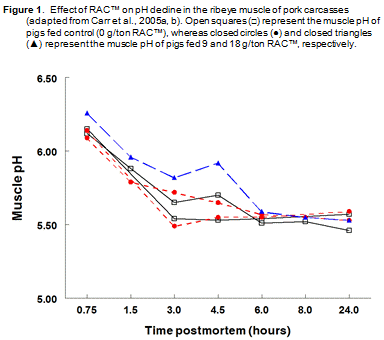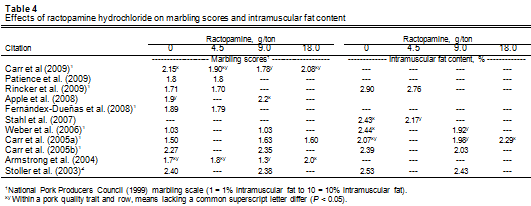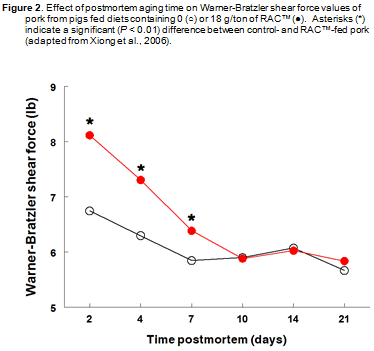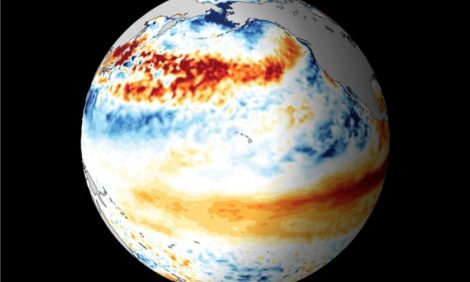



Influence of Paylean (Ractopamine Hydrochloride) on Pork Quality
An overview of the effects of ractopamine hydrochloride on fresh pork quality and cooked pork palatability by Dr Jason K. Apple of the University of Arkansas. Its inclusion in the late-finishing diet has no detrimental effects on muscle pH, fresh pork colour, firmness/wetness, water-holding capacity or marbling/intramuscular fat content but some experiments have revealed changes in fatty acid composition of the carcass fat and adverse effects on pork tenderness.Introduction
Marketed under the trade-name PayleanTM (Elanco Animal Health, Greenfield, Indiana), ractopamine hydrochloride (RAC) is a phenethanolamine Β-adrenergic agonist used as a feed supplement to redirect nutrients to improve live pig performance (daily gain and feed conversion efficiency) and fat-free lean yields in pork carcasses.
Research was initiated in the 1980s and RAC was FDA-approved for inclusion in swine finishing diets in December 1999. Initial approval included an inclusion range of 4.5 to 18g per ton and fed from 150 to 240lb. In 2006, the label changed to include an inclusion range from 4.5 to 9g per ton of feed and to be fed for the last 50 to 90lbs of body weight gain prior to market.
This overview summarises all levels of Paylean feeding; however, as producers consider the current, approved feeding level, more emphasis should be placed on the 4.5 to 9g per ton data. The specific focus of this factsheet is an overview of the effects of RAC on fresh pork quality and cooked pork palatability.
Objectives
- discuss the effects of Paylean on fresh pork quality
- discuss the effects of Paylean on consumer acceptance of pork
Muscle pH
Muscle pH is used to determine the level of acidity or alkalinity, and muscle pH is associated with many fresh pork quality attributes, including colour, firmness and water-holding capacity. In the conversion of muscle to meat, muscle becomes more acidic, with pH declining from a pH of 7.0-7.1 at death to an ultimate pH value of 5.40-6.00 at 24 hours post-mortem. Although research has reported that pH measured at 45 minutes post-mortem was reduced by the addition of 9 and 18g per ton of RAC, the majority of research studies have failed to detect an effect of RAC on muscle pH measured at 45 minutes post-mortem. When pigs were fed 9 or 18g per ton of RAC, loin muscle pH values measured at 0.75, 1.5, 3.0, 4.5, 6.0, 8.0 and 24 hours post-mortem were similar to those of pigs fed diets devoid of RAC (Figure 1).
Research has indicated that feeding 4.5g per ton of RAC for the last 28 days prior to slaughter effectively elevated muscle pH measured at 24 hours and seven days post-mortem, and an additional report indicates that including 9g per ton of RAC for the final 35 days prior to slaughter increased muscle pH measured 48 hours post-mortem. However, in contrast, most research indicates that neither 4.5, nor 18g per ton of RAC altered ultimate (24- or 48-hour) muscle pH.

Fresh Pork Colour
The colour of fresh pork is one of the most important quality characteristics affecting consumers' purchasing decisions, as well as the exportability of fresh pork products.
One study has indicated that pork from pigs fed 9g per ton RAC received greater (darker) NPPC and Japanese colour scores than pork from pigs fed 18g per ton RAC, while subjective colour scores for pork from pigs fed 0 or 4.5g per ton RAC were numerically intermediate and not statistically different from pigs fed 9 or 18g per ton (Table 1). Moreover, across five days of retail display, loin chops from pigs fed 9g per ton RAC received greater (darker) NPPC and Japanese colour scores than chops from control-fed pigs. However, based on a large number of reported results, feeding pigs finishing diets formulated with 4.5, 9 or 18 g per ton RAC had no detrimental effects on visually evaluated fresh pork colour.

Packers typically measure and benchmark pork colour based on instrumentally measured colour, in particular, lightness (L*), redness (a*), and yellowness (b*) values. Although research has indicated that pork loin chops from pigs fed 4.5 and 9g per ton RAC, respectively, were darker (lower L* values) than chops from control-fed pigs (Table 2), the consensus of available research indicates that L* values are not affected by feeding 4.5, 9 or 18g per ton RAC.
While one literature report indicated that a* (redness) values of fresh loin chops and ham were not different between pigs fed 0 and 4.5g per ton RAC, the majority of literature findings indicate that pork from pigs fed diets devoid of RAC is redder (greater a* values) and more yellow (greater b* values) than pork from pigs fed 4.5, 9 or 18g per ton RAC. It should be noted that pork consumers may not notice the subtle changes in instrumental colour measures of redness (a*) and yellowness (b*), especially when considering there were no differences in subjective colour scores, as mentioned previously.

Firmness and Water-Holding Capacity
Firmness is the subjective measure of pork's ability to hold its shape and is an indirect indicator of the water-holding capacity of pork. Typically, firmness and wetness are evaluated simultaneously, and, although Herr et al. (2001) observed that loin chops from pigs fed 18g per ton RAC were firmer than chops from control-fed pigs (Table 3), most research has failed to detect a difference in firmness/wetness between pork from pigs fed 4.5, 9 or 18 g per ton RAC.
The ability of pork to retain water after cutting, storage, and/or the application of a force is generally referred to as water-holding capacity (WHC). Typical measures of WHC include 'purge loss' – moisture lost during vacuum-packaged storage – and 'drip loss' – moisture loss from pork cuts or pork samples during a 24- to 48-hour storage period. Research has indicated that purge loss decreased linearly as the dietary inclusion level of RAC increased from 4.5 to 18g per ton when compared with pork from pigs fed the control diet. However, a meta-analysis of available research indicated that RAC, regardless of dietary inclusion level, had no detrimental effect on the WHC of fresh pork.

Marbling
Greater amounts of marbling or intramuscular fat (IMF) can have beneficial effects on cooked pork palatability, especially flavour intensity and tenderness. The vast majority of the available research has not detected a difference in visual marbling score between RAC- and control-fed pigs, and meta-analysis of the available literature also indicates that dietary RAC does not negatively impact marbling score. Of note, early RAC research results have shown that pork marbling scores actually increased by feeding 4.5, 9 and 18g per ton of RAC in finishing diets when compared to the control diet.
Intramuscular fat levels of the pork loin were not influenced by dietary RAC level. Interestingly, in research conducted prior to FDA approval, it has been reported that feeding 18g per ton of RAC reduced visual marbling scores of the loin muscle by 7.2 per cent but the IMF content of the same muscle samples was actually increased by more than 10 per cent when compared with pigs fed a control diet (0g per ton). Available literature clearly indicates that RAC has little, if any, effect on marbling or IMF.

Cooked Pork Palatability
Cooked pork palatability includes the perceptions of juiciness, tenderness, flavour intensity and the presence/absence of off-flavours. Most research employs trained sensory panelists (using linear scales) to ascertain differences in these properties.
Researchers have reported a tendency for pork from pigs fed 4.5g per ton RAC to receive lesser pork-flavour intensity scores than pork from control-fed pigs. However, panellists failed to note differences in juiciness, flavour desirability or overall acceptability.
Trained panelists were not able discern differences in juiciness and pork flavour when comparing pork from pigs fed 0 or 4.5g per ton RAC. Moreover, when comparing pork from pigs fed 9 or 18g per ton RAC with pigs fed a control diet, panellists were not able to detect differences in juiciness or flavour intensity ratings. On the other hand, several studies have demonstrated that pork loin chops from pigs fed 4.5, 9 and 18 g per ton of RAC received less desirable tenderness scores than chops from pigs finished on diets without added RAC.
The effect of RAC on Warner-Bratzler shear force (WBSF) values, the standard objective measurement of cooked meat tenderness, remains a controversial topic. Several studies failed to observe an effect of feeding 4.5, 9 or 18g per ton of RAC on WBSF values of cooked pork. However, cooked pork chop WBSF values were increased between eight and 12 per cent by feeding 9g per ton of RAC and between nine and 18 per cent by feeding 18g per ton RAC.
More recently, research has shown that feeding 4.5g per ton of RAC increased shear force values of cooked pork over 10 per cent. Pork loin chops from gilts fed 4.5g per ton RAC have been reported to have greater WBSF values than control-fed gilts; however, no differences in WBSF force values were observed between chops of barrows fed 0 or 4.5g per ton of RAC.
It is generally accepted that to optimise the growth performance and efficiency of RAC-fed pigs that the dietary lysine content of the finishing diet must be increased between 0.73 to 1.08 per cent. In addition, there is considerable information indicating that WBSF values increase, and sensory panel tenderness scores decrease, in response to increased dietary protein, dietary lysine, or increased lysine-to-energy ratio.
In fact, research has noted that the WBSF values of chops from pigs fed 9g per ton RAC increased linearly as the lysine-to-energy ratio increased from 1.7 to 3.1g lysine per Mcal of ME; thus, reductions in cooked pork tenderness may be a result of increased dietary protein/lysine content and not a response to RAC per se.
Additional research has indicated that pork from RAC-fed pigs had greater WBSF values after two, four and seven days of aging than pork from control pigs; however, there were no differences in WBSF values between chops from RAC- and control-fed pigs when chops were allowed to age 10, 14 or 21 days post-mortem (Figure 2). Therefore, extending post-mortem storage to 10 days, or greater, may diminish any pork toughening associated with feeding RAC.

Fat and Fresh Pork Belly Quality
Soft pork fat and bellies are an economic concern for pork processors, as they can result in carcass handling and processing difficulties, reduced bacon yields, unattractive products, reduced shelf-life and consumer discrimination. An increase in the incidence of soft fat has been attributed to the adoption of leaner, faster-growing genetics and or the increased use of polyunsaturated dietary fats/oils as cost-effective dietary energy sources.
Fat hardness has been shown to decrease in pigs fed RAC and the finding was attributed to a reduction in fat accumulation in the RAC-fed pigs. Moreover, others have reported that the proportion of saturated fatty acids (SFA) in subcutaneous backfat was reduced; whereas the proportion of polyunsaturated fatty acids (PUFA) in backfat was increased by including RAC in the finishing diet. In contrast, fatty acid profiles of backfat from control-fed pigs and pigs fed 4.5g per ton RAC were similar, while in other research the PUFA content was increased between 6.9 and 9.9 per cent in the backfat from pigs fed 9g per ton RAC.
The decrease in saturated fat level of pork backfat from RAC-fed pigs has been attributed to a much greater deposition of linoleic acid and linolenic acid when compared with backfat from control-fed pigs. Others have reported that RAC depressed the biosynthesis of fatty acids from glucose in porcine fat; therefore, the fatty acid content of pork backfat would be a greater reflection of the fatty acids absorbed from the digestion of the fats and/or oils included in the finishing diet. The increase in unsaturated fatty acids due to feeding RAC is significantly less than the increase observed when feeding highly unsaturated lipids from plant sources.
Ractopamine, as a result of the noted greater degree of unsaturated fat in fat depots, has been suggested to increase the percentage of thin/soft pork bellies within the pork industry. However, research results have not supported this finding, whereby feeding RAC did not influence fresh belly thickness. Although one study has noted that feeding 9g per ton RAC reduced belly firmness, additional available research indicates that belly firmness does not differ between pigs fed RAC or a control diet. Moreover, others have reported that pickle uptake was greater in bellies from pigs fed 4.5g per ton RAC than control-fed pigs, and the total slice area, slice length and slice lean area were also greater in bacon from RAC-fed pigs. Of note, trained sensory panelists were not able to detect differences in the texture and flavor profiles of bacon derived from control- and RAC-fed pigs.
Implications
Based on available literature, the inclusion of RAC in the late-finishing diet has no detrimental effects on muscle pH, fresh pork colour, firmness/wetness, water-holding capacity or marbling/IMF content.
Feeding RAC may result in greater deposition of polyunsaturated fats but there is no evidence that RAC directly compromises pork fat or fresh belly quality.
In addition, although a number of studies have reported that feeding RAC reduced cooked pork tenderness, extending the post-mortem aging time to at least 10 days, while increasing storage costs within the industry, appears to diminish the negative effect of RAC on pork tenderness.
Literature Cited
[1] Apple, J.K., P.J. Rincker, F.K. McKeith, S.N. Carr, T.A. Armstrong and P.D. Matzat. 2007. Meta-analysis of ractopamine response in finishing swine. Prof. Anim. Sci. 23:179-196.
[2] Aalhus, J.L., S.D.M. Jones, A.L. Schaefer, A.K.W. Tong, W.M. Robertson, J.K. Merrill and A.C. Murray. 1990. The effect of ractopamine on performance, carcass composition and meat quality of finishing pigs. Can. J. Anim. Sci. 70:943-952.
[3] Carr, S.N., D.J. Ivers, D.B. Anderson, D.J. Jones, D.H. Mowrey, M.B. England, J. Killefer, P.J. Rincker and F.K. McKeith. 2005. The effects of ractopamine hydrochloride on lean carcass yields and pork quality characteristics. J. Anim. Sci. 83:2886-2893.
[4] Weber, T.E., B.T. Richert, M.A. Belury, Y. Gu, K. Enright and A.P. Schinckel. 2006. Evaluation of the effects of dietary fat, conjugated linoleic acid, and ractopamine on growth performance, pork quality, and fatty acid profiles in genetically lean gilts. J. Anim. Sci. 84:720-732.
[5] Carr, S.N., P.J. Rincker, J. Killefer, D.H. Baker, M. Ellis and F.K. McKeith. 2005. Effects of different cereal grains and ractopamine hydrochloride on performance, carcass characteristics, and fat quality in late-finishing pigs. J. Anim. Sci. 83:223-230.
[6] Rincker, P.J., J. Killefer, P.D. Matzat, S.N. Carr and F.K. McKeith. 2009. The effect of ractopamine and intramuscular fat content on sensory attributes of pork from pigs of similar genetics. J. Muscle Foods 20:79-88.
[7] Apple, J.K., C.V. Maxwell, B.R. Kutz, L.K. Rakes, J.T. Sawyer, Z.B. Johnson, T.A. Armstrong, S.N. Carr and P.D. Matzat. 2008. Interactive effect of ractopamine and dietary fat source on pork quality characteristics of fresh pork chops during simulated retail display. J. Anim. Sci. 86:2711-2722.
[8] Stahl, C.A., M.S. Carlson-Shannon, B.R. Wiegand, D.L. Meyer, T.B. Schmidt and E.P. Berg. 2007. The influence of creatine and high glycemic carbohydrate on the growth performance and meat quality of market hogs fed ractopamine hydrochloride. Meat Sci. 75:143-149.
[9] Fernándex-Dueñas, D.M., A.J. Myers, S.M. Scramlin, C.W. Parks, S.N. Carr, J. Killefer and F.K. McKeith. 2008. Carcass, meat quality, and sensory characteristics of heavy body weight pigs fed ractopamine hydrochloride (Paylean). J. Anim. Sci. 86:3544-3550.
[10] Patience, J.F., P. Shand, Z. Pietrasik, J. Merrill, G. Vessie, K.A. Ross and A.D. Beaulieu. 2009. The effect of ractopamine supplementation at 5 ppm of swine finishing diets on growth performance, carcass composition and ultimate pork quality. Can. J. Anim. Sci. 89:53-66.
[11] Herr, C.T., S.L. Hankins, A.P. Schinckel and B.T. Richert. 2001. Evaluation of three genetic populations of pigs for response to increasing levels of ractopamine. J. Anim. Sci. 79(Suppl. 2):73. (Abstr.)
[12] Stoller, G.M., H.N. Zerby, S.J. Moeller, T.J. Baas, C. Johnson and L.E. Watkins. 2003. The effect of feeding ractopamine (Paylean) on muscle quality and sensory characteristics in three diverse genetic lines of swine. J. Anim. Sci. 81:1508-1516.
[13] Stites, C.R., F.K. McKeith, S.D. Singh, P.J. Bechtel, D.J. Jones and D.H. Mowrey. 1994. Palatability and visual characteristics of hams and loin chops from swine treated with ractopamine hydrochloride. J. Muscle Foods 5:367-376.
[14] Brewer, M.S. and F.K. McKeith. 1999. Consumer-related quality characteristics as related to purchase intent of fresh pork. J. Food Sci. 64:171-174.
[15] Morgan, J.B., G.C. Smith, J. Cannon, F. McKeith and J. Heavner. 1994. Pork distribution channel audit report. Pages 30-40 in Pork Chain Quality Audit – Progress Report. D. Meeker and S. Sonka, ed. National Pork Producers Council Publication, Des Moines, IA.
[16] Armstrong, T.A., D.J. Ivers, J.R. Wagner, D.B. Anderson, W.C. Weldon and E.P. Berg. 2004. The effect of dietary ractopamine concentration and duration of feeding on growth performance, carcass characteristics, and meat quality of finishing pigs. J. Anim. Sci. 82:3245-3253.
[17] Carr, S.N., D.N. Hamilton, K.D. Miller, A.L. Schroeder, D. Fernándex-Dueñas, J. Killefer, M. Ellis and F.K. McKeith. 2009. The effect of ractopamine hydrochloride (Paylean®) on lean carcass yields and pork quality characteristics of heavy pigs fed normal and amino acid fortified diets. Meat Sci. 81:533-539.
[18] Apple, J.K. 2007. Effects of nutritional modifications on the water-holding capacity of fresh pork: a review. J. Anim. Breed. Genet. 124(Suppl. 1):43-58
[19] Watkins, L.E., D.J. Jones, D.H. Mowrey, D.B. Anderson and E.L. Veenhuizen. 1990. The effect of various levels of ractopamine hydrochloride on the performance and carcass characteristics of finishing swine. J. Anim. Sci. 68:3588-3595.
[20] Schinckel, A.P., N. Li, B.T. Richert, P.V. Preckel and M.E. Einstein. 2003. Development of a model to describe the composition growth and dietary lysine requirements of pigs fed ractopamine. J. Anim. Sci. 81:1106-1119.
[21] Webster, M.J., R.D. Goodband, M.D. Tokach, J.A. Unruh, J.L. Nelssen, S.S. Dritz, D.E. Real, J.M. DeRouchey, J.C. Woodworth and T.A. Marstellar. 2002. Interactive effects between Paylean (ractopamine HCl) and dietary lysine on finishing pig growth performance, carcass characteristics and tissue accretion. J. Anim. Sci. 80(Suppl. 2):78. (Abstr.)
[22] Goerl, K.F., S.J. Eilert, R.W. Mandigo, H.Y. Chen and P.S. Miller. 1995. Pork characteristics as affected by two populations of swine and six crude protein levels. J. Anim. Sci. 73:3621-3626.
[23] Goodband, R.D., J.L. Nelssen, R.H. Hines, D.H. Kropf, R.C. Thaler, B.R. Schricker, G.E. Fitzner and A.J. Lewis. 1990. The effects of porcine somatotropin and dietary lysine on growth performance and carcass characteristics of finishing swine. J. Anim. Sci. 68:3261-3276.
[24] Castell, A.G., R.L. Cliplef, L.M. Poste-Flynn and G. Butler. 1994. Performance, carcass and pork characteristics of castrates and gilts self-fed diets differing in protein content and lysine:energy ratio. Can. J. Anim. Sci. 74:519-528.
[25] Cameron, N.D., J.C. Penman, A.C. Fisken, G.R. Nute, A.M. Perry and J.D. Wood. 1999. Genotype with nutrition interactions for carcass composition and meat quality in pig genotypes selected for components of efficient lean growth rate. Anim. Sci. 69:69-80.
[26] Apple, J.K., C.V. Maxwell, D.C. Brown, K.G. Friesen, R.E. Musser, Z.B. Johnson and T.A. Armstrong. 2004. Effects of dietary lysine and energy density on performance and carcass characteristics of finishing pigs fed ractopamine. J. Anim. Sci. 82:3277-3287.
[27] Perkins, E.G., F.K. McKeith, D.J. Jones, D.H. Mowrey, S.E. Hill, J. Novakofski and P.L. O’Connor. 1992. Fatty acid and cholesterol changes in pork longissimus muscle and fat due to ractopamine. J. Food Sci. 57:1266-1268.
[28] Xiong, Y.L., M.J. Gower, C. Li, C.A. Elmore, G.L. Cromwell and M.D. Lindemann. 2006. Effect of dietary ractopamine on tenderness and postmortem protein degradation of pork muscle. Meat Sci. 73:600-604.
[29] Xi, L., M.T. See, K.N. Wentz, J. Odle, B.A. Belstra, T.A. Armstrong, P.D. Matzat, P.J. Rincker, F.K. McKeith, M. Culbertson, W. Herring and J. Hansen. 2005. The effect of ractopamine feeding level on fatty acid profiles in belly and clearplate fat of finishing pigs. J. Anim. Sci. 83(Supple. 2):28. (Abstr.)
[30] Mills, S.E., C.Y. Liu, Y. Gu and A.P. Schinckel. 1990. Effects of ractopamine on adipose tissue metabolism and insulin binding in finishing hogs. Interaction with genotype and slaughter weight. Domest. Anim. Endocrinol. 7:251-264.
[31] Apple, J.K., C.V. Maxwell, J.T. Sawyer, B.R. Kutz, L.K. Rakes, M.E. Davis, Z.B. Johnson, S.N. Carr and T.A. Armstrong. 2007a. Interactive effect of ractopamine and dietary fat source on quality characteristics of fresh pork bellies. J. Anim. Sci. 85:2682-2690.
[32] Uttaro, B.E., R.O. Ball, P. Dick, W. Rae, G. Vessie and L.E. Jeremiah. 1993. Effect of ractopamine and sex on growth, carcass characteristics, processing yield, and meat quality characteristics of crossbred swine. J. Anim. Sci. 71:2439-2449.
[33] Scramlin, S.M., S.N. Carr, C.W. Parks, D.M. Fernándex-Dueñas, C.M. Leick, F.K. McKeith and J. Killefer. 2008. Effect of ractopamine level, gender, and duration of ractopamine on belly and bacon quality traits. Meat Sci. 80:1218-1221.
[34] Jeremiah, L.E., R.O. Ball, J.K. Merrill, P. Dick, L. Stobbs, L.L. Gibson and B. Uttaro. 1994a. Effects of feed treatment and gender on the flavour and texture profiles of cured and uncured pork cuts. I. Ractopamine treatment and dietary protein level. Meat Sci. 37:1-20.
[35] Jeremiah, L.E., J.K. Merrill, L. Stobbs, L.L. Gibson and R. Gibson. 1994b. Effects of feed treatment and gender on the flavour and texture profiles of cured and uncured pork cuts. II. Ractopamine treatment and dietary protein source. Meat Sci. 37:21-35.
March 2013






